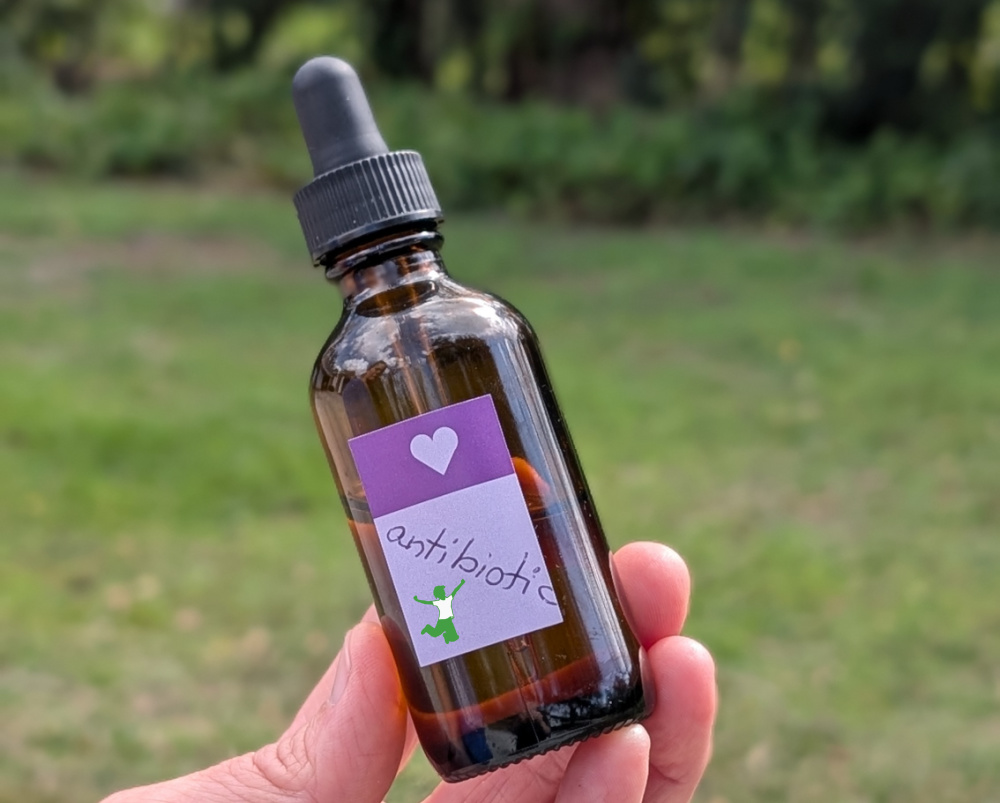Table of Contents[Hide][Show]
How to make your own liquid antibiotic at home that is as effective as prescription versions and yet will not harm the gut microbiome or fail to work against drug-resistant pathogens.

Some of the most damaging pharmaceuticals in existence are the liquid amoxicillin drops that pediatricians prescribe like candy for babies and young children.
I was prescribed this toxic poison when my first child was a little over a year old.
He had an ear infection and the best the doctor could suggest was a gut-destroying drug.
Sad!
Not wanting to give him the antibiotic, I used holistic methods instead to resolve the problem.
As a brief aside…I also made a big change in our family’s diet so that he never got another ear infection again (and my next two children never got one either!).
The simple change was to swap out pasteurized dairy for raw dairy.
Problem solved!
Getting back to the toxic liquid antibiotics which is one of the top prescriptions for babies and children…did you know that you can make an equally effective version yourself that does NOT harm the gut microbiome?
This homemade liquid antibiotic concentrates the most powerful natural antimicrobial that I’ve ever come across…allicin from raw garlic.
Allicin has three anti-microbial benefits that make it the perfect candidate for DIY antibiotic drops.
First of all, it is a natural antifungal as well as antibacterial, and anti-viral (aka, microscopic parasites).
No single pharmaceutical drug has this same broad-spectrum anti-microbial benefit.
Thus, unlike pharmaceutical antibiotic drops, a homemade version using concentrated allicin will root out other pathogenic microbes, not just bad bacteria!
What’s even better, pathogenic microbes don’t seem to be able to develop resistance to allicin over time, unlike conventional medications.
Best of all, ingestion of allicin does not harm beneficial gut microbes or reduce their diversity, unlike many pharmaceutical drugs.
In fact, initial research suggests that garlic acts as a prebiotic, increasing microbial richness and diversity with a marked increase in the beneficial and immune-stimulating bacteria, notably the species Lactobacillus and Clostridia. These changes occur within a 3-month period.
Allicin has even proven helpful in the fight against superbugs. It is sometimes deployed to treat MRSA when antibiotics fail.
Make Your Own Liquid Antibiotic!
All you need to make your own liquid antibiotic is concentrated allicin powder from raw garlic and filtered water.
The best brand of concentrated allicin I’ve used over the years is Allimax.
Allimax used to have a regular and mid-strength liquid version, but it is no longer available for some reason.
So, I’ve taken to making my own which is super simple!
Easy DIY Steps
To blend your own liquid antibiotic, empty 3 regular strength Allimax capsules in a 2-ounce glass bottle.
Carefully add 25 drops of filtered water (1/4 teaspoon) to the bottle.
Affix the lid and turn several times to mix well.
That’s it!
You now have a liquid antibiotic ready to go.
I recommend refrigerating the bottle to keep it as fresh as possible. It will last about a month refrigerated.
I suggest making small batches so you never waste any.
Dosage for Pediatric Conditions
The following is the dosage guide for your homemade liquid antibiotic for pediatric conditions based on age.
- Ages 3 months – 1 year: 3 drops twice per day
- Ages 2-5 years: 6 drops three times per day
- Ages 6-12 years: 12 drops two or three times per day
Conditions such as ear infections, upper respiratory infections (URI), sore throat, diarrhea, thrush, and diaper rash are appropriate for its use according to the Allimax dosing chart (scroll down for the pediatric chart).
Adults Who Can’t Swallow Pills
This homemade liquid antibiotic can also be useful for older children or adults who have a strong gag reflex or otherwise have trouble swallowing pills.
To calculate the number of drops of the liquid antibiotic needed for a given illness, use this dosage chart to determine what type (and how many) allimax capsules (regular, mid or professional strength) are needed.
Then, convert the capsules to liquid using this guide:
- For regular-strength Allimax, the equivalent is 6 drops to 1 Allimax capsule (180 mg stabilized allicin).
- For mid-strenth AlliUltra, the equivalent is 12 drops to 1 AlliUltra capsule (360 mg of stabilized allicin).
- For professional strength AlliMed, the equivalent is 15 drops per Allimed capsule (450 mg stabilized allicin). Alternatively, the liquid version of Allimed is still available with fewer drops needed.
External Uses
If you’ve been wondering if this liquid antibiotic can be used on the skin…it most definitely can!
In fact, it is a safe, additive-free alternative to petroleum-based triple antibiotic ointments.
I hope you find this homemade liquid antibiotic useful for those in your home to avoid the toxic, fake flavored, and artificially colored antibiotic drops from the pharmacy that can contribute to lifelong struggles with gut imbalance and the autoimmune diseases that often accompany it.
References
(1) Alliin: An Overview
(2) Garlic: A Review of Potential Therapeutic Benefits
(3) The Effect of Aged Garlic on Gut Microbiota
(4) Fresh Garlic Extract Enhances the Antimicrobial Activities of Antibiotics on Resistant Strains
(5) Pediatric Liquid Allimax Dosing Chart

